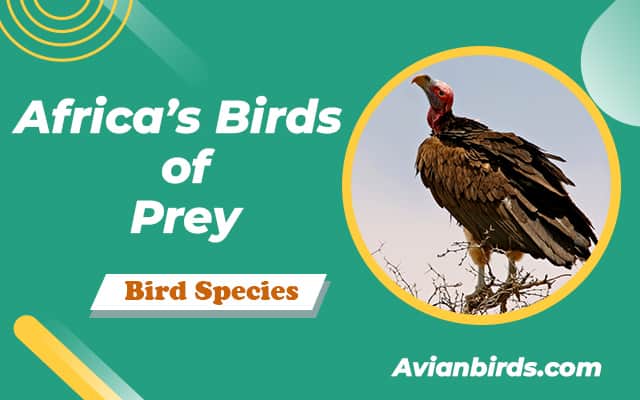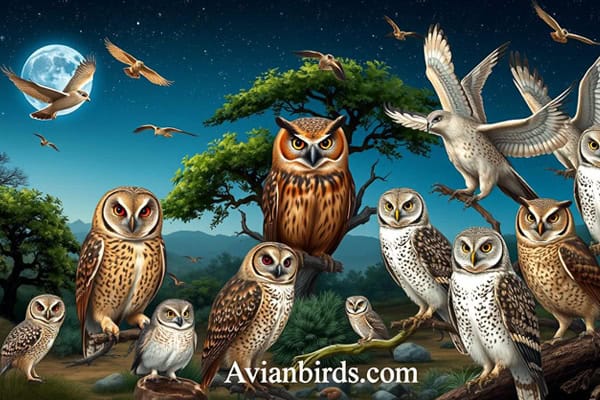Africa’s Birds of Prey (With Pictures & Facts)
Africa’s Birds of Prey are a testament to nature’s splendor. I’ve researched these majestic creatures, from the regal eagles to the enigmatic owls and swift hawks. Their prowess is captivating, each species a marvel in the skies. Let’s explore their world together, uncovering the secrets of their survival and grace. It’s a journey into the wild heart of Africa, where these predators reign supreme. Come, let’s witness their story unfold and be inspired by their fierce beauty.
Here are the main points:
- Africa is home to a wide variety of captivating Birds of Prey.
- These winged predators inspire awe with their majestic appearances and remarkable hunting abilities.
- Eagles, owls, hawks, kites, vultures, falcons, seriemas, and secretarybirds are among the diverse species found in Africa.
- Africa’s Birds of Prey play crucial roles in maintaining the balance of ecosystems.
- Join us as we explore the fascinating world of Africa’s avian predators and learn more about their unique characteristics and behaviors.
What Are Raptors?
Before we dive into the specifics of Africa’s Birds of Prey, let’s first understand what raptors are. Raptors, also known as Birds of Prey, are a group of birds characterized by their sharp, curved talons and hooked beaks. These predatory birds have keen eyesight, powerful wings, and strong feet, making them excellent hunters. Raptors come in various shapes and sizes, ranging from small falcons to large eagles.
Raptors have evolved to be specialized hunters, with adaptations that allow them to thrive in different environments. Their talons are designed to grasp and immobilize prey, while their hooked beaks are perfect for tearing meat. They possess exceptional eyesight, enabling them to spot prey from great distances. Their powerful wings allow them to soar effortlessly through the skies, while their strong feet provide the necessary grip.
These exceptional birds are not only skilled hunters but also play a crucial role in maintaining a balanced ecosystem. By regulating prey populations, raptors help prevent overpopulation and keep the food chain in check.
Characteristics of Raptors:
- Sharp, curved talons
- Hooked beaks
- Keen eyesight
- Powerful wings
- Strong feet
“Raptors are magnificent birds with incredible hunting abilities. Their unique adaptations make them some of the most successful predators in the animal kingdom.”
Species of Raptors in Africa:
Africa is home to a diverse array of raptors, each with its own unique characteristics and behaviors. Here are just a few examples:
| Raptor | Scientific Name | Characteristic |
|---|---|---|
| African Fish Eagle | Haliaeetus vocifer | Distinctive call and striking appearance |
| Martial Eagle | Polemaetus bellicosus | Massive size and formidable hunting skills |
| Brown Snake Eagle | Circaetus cinereus | Specialized in preying on reptiles |
| Bateleur | Terathopius ecaudatus | Distinctive coloring and acrobatic flight |
These are just a few examples of the remarkable raptors found in Africa. Join us as we continue to explore the fascinating world of Africa’s Birds of Prey.
Eagles
African Fish Eagle

In Africa, African Fish Eagle is one of the most majestic and iconic eagles. Its striking appearance and distinctive call make it a true symbol of African wilderness. This regal creature reigns supreme, soaring high above the vast landscapes.
Martial Eagle

Another remarkable eagle found in Africa is the Martial Eagle. With its massive size and impressive wingspan, it is a formidable hunter. Wildlife enthusiasts are often captivated by its presence in the African savannah.
Brown Snake Eagle

Preying on reptiles, the Brown Snake Eagle is a specialized eagle species. Known for its keen eyesight and agile hunting skills, it swoops down from the skies to catch its elusive prey. This adaptive bird is always ready to strike.
Bateleur
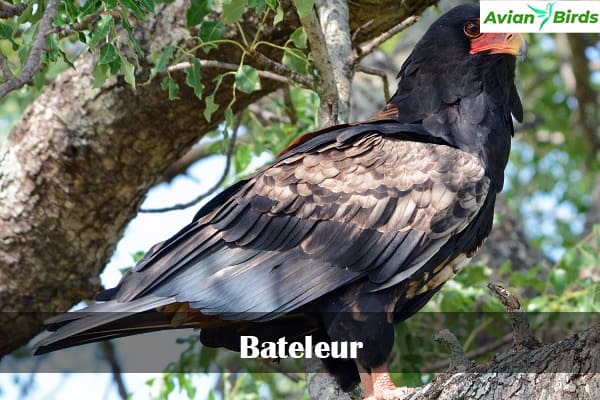
The Bateleur, with its unique coloring and aerial acrobatics, is a true spectacle in flight. Its bold red face and contrasting black wings make it easily recognizable. Watching this fascinating eagle soar through the air is a sight that leaves us in awe.
“The beauty and grace of the African eagle species never fail to amaze us. Their presence in the wild evokes a sense of wonder and reverence.” – African Wildlife Society
Owls
Owls, with their nocturnal habits and mysterious demeanor, hold a special place among Birds of Prey. Africa is home to a variety of owl species, including the majestic Giant Eagle Owl, the sought-after Pel’s Fishing Owl, and the elusive African Scops Owl. The adorable Pearl-spotted Owlet and the African Wood Owl also grace the African night skies, along with the Western Barn Owl.
Giant Eagle Owl
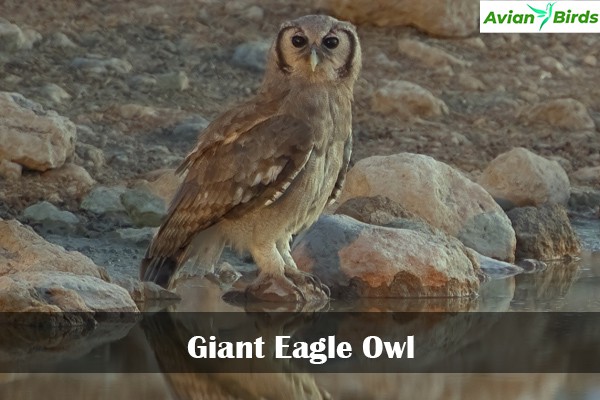
The Giant Eagle Owl is a formidable predator known for its impressive wingspan of up to 6 feet. With its striking bright orange eyes and ear tufts, this owl species commands attention. Preferring savannah woodlands and forests, the Giant Eagle Owl is a powerful hunter, feeding on a variety of prey including small mammals, birds, and reptiles.
Sought-After Pel’s Fishing Owl

If you’re lucky enough to spot a Pel’s Fishing Owl in the wild, you’re in for a treat. This large owl, with its unique appearance and distinct call, is a highly sought-after sighting for bird enthusiasts. Named for its preference for riverbanks and wetland habitats, the Pel’s Fishing Owl is an expert fisher, using its sharp talons to catch fish and other aquatic prey.
Elusive African Scops Owl

The African Scops Owl is a small and cryptic owl species that is often heard but rarely seen. With its excellent camouflage and skill at remaining hidden during daylight hours, spotting this owl can be a challenge. However, its distinctive call echoes through the African night, adding an air of mystery to the wilderness.
Adorable Pearl-spotted Owlet

If you’re looking for a cute and compact owl, the Pearl-spotted Owlet fits the bill. With its tiny size and striking white eyebrow spots, this owl species captures hearts wherever it’s found. Found in woodland areas and savannahs, the Pearl-spotted Owlet feeds primarily on insects, small birds, and rodents.
African Wood Owl
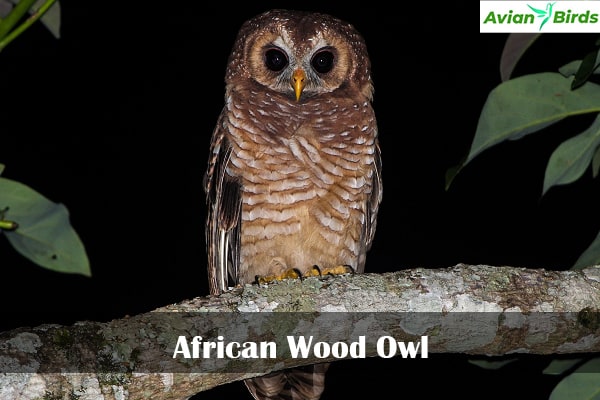
The African Wood Owl is a medium-sized owl known for its enigmatic presence. With its dark, mottled plumage and distinct facial disk, this owl species is perfectly adapted for its forested habitats. The African Wood Owl relies on stealth and silence to hunt its prey, which includes small mammals and birds.
Nocturnal Western Barn Owl
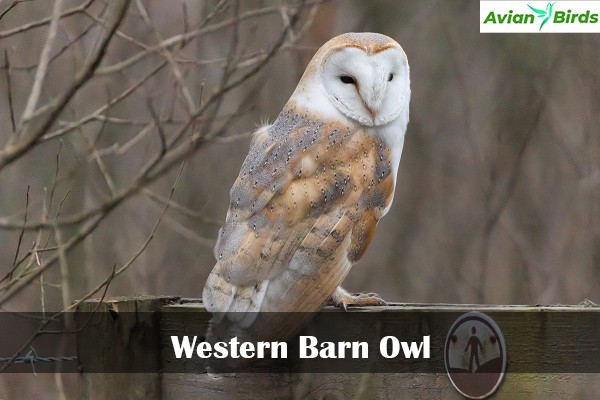
The Western Barn Owl is a familiar sight in the African night skies. With its heart-shaped face and ghostly white plumage, this owl species is well-suited to its wide range of habitats. The Western Barn Owl hunts primarily at night, using its exceptional hearing and silent flight to catch small mammals, birds, and insects.
| Owl Species | Habitat | Primary Prey |
|---|---|---|
| Giant Eagle Owl | Savannah woodlands and forests | Small mammals, birds, reptiles |
| Pel’s Fishing Owl | Riverbanks and wetlands | Fish and aquatic prey |
| African Scops Owl | Various habitats | *Various* |
| Pearl-spotted Owlet | Woodland areas and savannahs | Insects, small birds, rodents |
| African Wood Owl | Forested habitats | Small mammals, birds |
| Western Barn Owl | Wide range of habitats | Small mammals, birds, insects |
Hawks
Hawks are agile and swift Birds of Prey, known for their predatory prowess. These magnificent birds have adapted to various habitats across Africa, showcasing their incredible hunting skills.
One notable species is the African Harrier-Hawk (Polyboroides typus), also known as the “Gymnogene.” This hawk possesses distinctive double-jointed legs that allow it to maneuver with exceptional dexterity. Equipped with sharp talons and a hooked beak, the African Harrier-Hawk specializes in raiding bird nests. It uses its long legs and flexible joints to reach deep into crevices in search of prey. Its ability to extract chicks and eggs from the safety of nesting sites sets it apart from other hawks.
The African Harrier-Hawk’s unique physical adaptations make it a formidable predator when it comes to raiding bird nests. Its double-jointed legs provide unmatched flexibility, enabling it to seize its prey with ease.
Another remarkable hawk species found in Africa is the Black Sparrow-Hawk (Accipiter melanoleucus). With its sleek black plumage and slender build, this master flyer effortlessly navigates the dense foliage of forests and woodlands. Its agile flight allows it to swiftly maneuver through trees, making it highly effective at hunting small birds, lizards, and insects.
African Goshawk
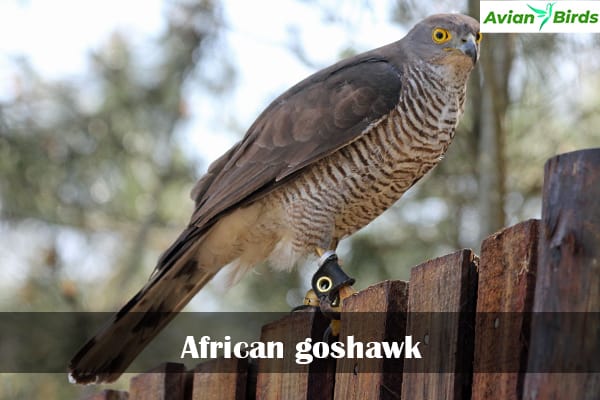
The African Goshawk (Accipiter tachiro) is renowned for its adaptability and versatility in various African habitats. This medium-sized hawk relies on its speed, agility, and sharp vision to hunt and capture its prey. Its preference for dense forests enables it to stealthily navigate through the trees, ambushing unsuspecting prey. The African Goshawk’s broad wings and long tail provide excellent maneuverability, making it an exceptional hunter in its chosen habitat.
African Harrier-Hawk

From the African Harrier-Hawk’s specialized nest-raiding techniques to the Black Sparrow-Hawk’s mastery of flight and the African Goshawk’s stealth in dense forests, these hawks showcase the diversity of behaviors and habitats among Africa’s Birds of Prey.
Black Sparrow-Hawk
The black sparrowhawk, Africa’s biggest true hawk and the world’s second-largest, measures about twenty inches long with a wingspan of around three feet. It lives in wooded areas throughout Africa below the Sahara, including cities and suburbs.

These hawks usually have black feathers with white patches on their throat, chest, and stomach. In some coastal parts of South Africa, you might spot a rare all-black variation. They hunt medium-sized birds and do particularly well in areas affected by human activity, where they can easily prey on doves and pigeons.
Hawk Species at a Glance
| Hawk Species | Physical Characteristics | Habitat | Prey |
|---|---|---|---|
| African Harrier-Hawk | Distinctive double-jointed legs, sharp talons, hooked beak | Varied, including woodlands, savannas, and grasslands | Chicks, eggs, small mammals, reptiles, and insects |
| Black Sparrow-Hawk | Sleek black plumage, slender build | Forests, woodlands, and dense vegetation | Small birds, lizards, and insects |
| African Goshawk | Medium-sized, broad wings, long tail | Dense forests and woodlands | Small mammals, birds, and reptiles |
Kites
Kites are medium-sized Birds of Prey that grace the African skies with their effortless soaring. These elegant raptors showcase remarkable hunting skills and captivating aerial displays.
Yellow-billed Kite

The Yellow-billed Kite is a common sight in Africa, known for its scavenging abilities and graceful acrobatics. With its distinct yellow beak and striking yellow eyes, this kite is a master of flight and opportunistic feeding.
Black-winged Kite

The Black-winged Kite, with its contrasting black and white plumage, is a stealthy predator specializing in hunting small rodents. This kite’s aerial agility and keen eyesight make it a formidable hunter, effortlessly navigating its environment in search of prey.
Witness the mesmerizing flight and hunting prowess of these remarkable Birds of Prey as they soar high above the African landscape.
Vultures
Vultures are an essential component of Africa’s ecosystem, serving as nature’s cleanup crew. These majestic birds of prey play a crucial role in maintaining the health and balance of their habitats.
Cape Vulture

The Cape Vulture is a remarkable species, known for its bald head and impressive wingspan. With its strong soaring abilities, it can cover great distances in search of carrion to feast upon.
Lappet-faced Vulture

The Lappet-faced Vulture is another notable member of the Vulture family. It possesses powerful scavenging capabilities, allowing it to efficiently clean up carcasses and prevent the spread of disease.
Bearded Vulture
The Bearded Vulture is a unique vulture species with fascinating dietary habits. While other vultures primarily consume carrion, the Bearded Vulture prefers a diet consisting mainly of bone marrow. This specialization sets it apart from other scavengers in the avian world.

These vultures are integral to the ecosystems they inhabit, ensuring the swift and efficient decomposition of animal remains. By removing carrion from the environment, they contribute to the overall health and sanitation of their habitats.
Comparison of Vulture Species
| Vulture Species | Physical Characteristics | Diet | Habitat | Conservation Status |
|---|---|---|---|---|
| Cape Vulture | Bald head, large wingspan | Carrion | Mountains, cliffs | Near threatened |
| Lappet-faced Vulture | Distinctive lappets on face, powerful beak | Carrion | Various habitats | Critically endangered |
| Bearded Vulture | Bearded appearance, long wings | Mainly bone marrow | Mountainous regions | Near threatened |
Despite their ecological importance, vultures face numerous challenges, including habitat loss, poisoning from toxic substances, and illegal trade. Efforts are underway to conserve these remarkable birds and raise awareness about their critical role in maintaining the balance of Africa’s ecosystems.
Falcons
Falcons are renowned for their exceptional speed and aerial agility. These magnificent birds of prey have captivated the human imagination for centuries with their incredible hunting abilities. Among the various species of falcons, one stands out as a true marvel of nature – the Peregrine Falcon.
“The Peregrine Falcon is the fastest animal on the planet, reaching speeds of over 240 miles per hour during its hunting dives.”
With its streamlined body and pointed wings, the Peregrine Falcon is built for speed. These birds are known for their astonishing hunting techniques, which include dramatic high-speed dives called “stoops.” During stoops, Peregrine Falcons tuck their wings and plummet toward their prey with unmatched precision.
Peregrine Falcon
Although the Peregrine Falcon can be found on every continent except Antarctica, it holds a special place in African ecosystems. From the arid deserts of the Sahara to the lush rainforests of Central Africa, these falcons have adapted to a wide range of habitats across the continent.
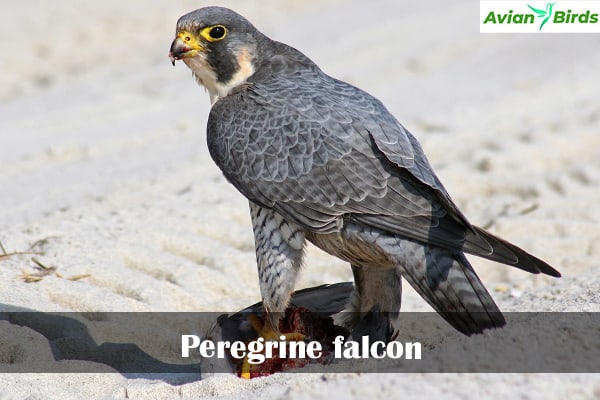
The Peregrine Falcon’s ability to thrive in diverse environments is a testament to its resilience and adaptability. It symbolizes both power and grace, captivating bird enthusiasts and scientists alike. These fascinating birds continue to inspire awe and wonder in those lucky enough to witness their breathtaking aerial displays.
Seriemas and Secretarybirds
In the realm of Africa’s Birds of Prey, Seriemas and Secretarybirds stand out as distinctive and captivating species. These avian predators bring their unique characteristics to the skies, showcasing fascinating behaviors and adaptations that set them apart.
Seriemas: A Cross Between Raptors and Cranes
Seriemas, also known as Cariamids, are a group of birds that resemble a cross between a raptor and a crane. With their slender bodies, long legs, and sharp beaks, they are agile hunters that roam the grasslands and woodlands of Africa. Seriemas are renowned for their impressive leaps, which they use to surprise their prey. Additionally, their haunting calls echo through the landscape, adding to their mystique.

Secretarybirds: Long-Legged Hunters
Secretarybirds, named for their distinctive crown of feathers resembling quills in an old-fashioned secretary’s ink pen, are true marvels of the avian world. These iconic African birds are equipped with exceptionally long legs and powerful beaks, making them effective hunters of small mammals and reptiles. Secretarybirds are known for their unique hunting technique of stomping on their prey with their strong feet, subsequently swallowing it whole.
“With their unique appearance and hunting behaviors, Secretarybirds are a testament to the wonders of nature’s design,” says Dr. Jane Simmons, a renowned ornithologist.
These large, elegant birds patrol the savannas and grasslands of Africa, their distinctive silhouette a familiar sight against the vast sky.
Comparing the Seriemas and Secretarybirds
| Species | Distinctive Features | Habitat | Prey |
|---|---|---|---|
| Seriemas | A cross between raptors and cranes | Grasslands and woodlands | Small mammals, birds, reptiles |
| Secretarybirds | Long legs, crown of feathers | Savannas and grasslands | Small mammals, reptiles |
The table above compares the distinctive features, habitats, and prey of Seriemas and Secretarybirds. While Seriemas exhibit a fusion of characteristics from raptors and cranes, Secretarybirds impress with their elongated legs and unique feeding habits.
Exploring the world of Seriemas and Secretarybirds is a captivating journey, highlighting the diversity and wonder of Africa’s Birds of Prey. These fascinating species remind us of the intricate beauty and complexity of the natural world.
Check Our Previous Articles
Final Thoughts:
Learning about Africa’s Birds of Prey has been exciting! From big eagles to mysterious owls, fast hawks, graceful falcons, and special birds like seriemas and secretarybirds, these predators are super cool.
They hunt in amazing ways and they are good at flying, and they’re important for keeping nature balanced. That’s why Africa’s Birds of Prey make our world more beautiful and diverse with their presence.

